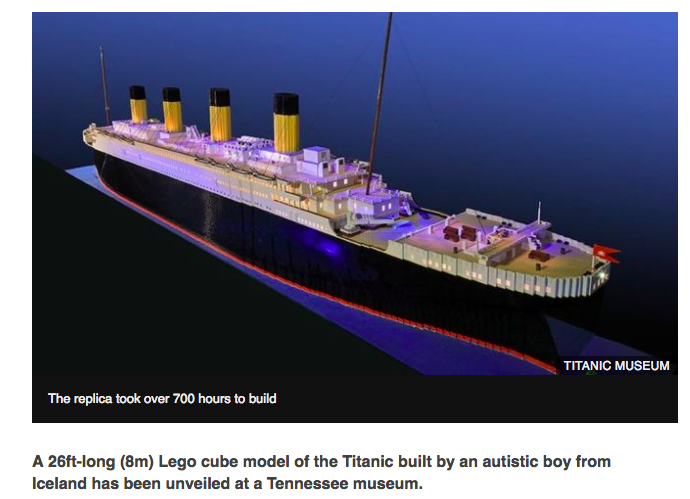What can a 15-year-old autistic boy from Iceland teach us about leadership?
 Last week videos went viral of a 28-foot-long model of the Titanic, designed and built out of 65,000 Lego blocks by teenager Brynjar Karl Birgisson. It is a remarkable feat of design, engineering, three-dimensional vision, and perseverance. But what I want to dig into is something else: the ability to see how every-day pieces can be combined in radically different ways to create something new and valuable, which is a pretty good indicator of innovation DNA.
Last week videos went viral of a 28-foot-long model of the Titanic, designed and built out of 65,000 Lego blocks by teenager Brynjar Karl Birgisson. It is a remarkable feat of design, engineering, three-dimensional vision, and perseverance. But what I want to dig into is something else: the ability to see how every-day pieces can be combined in radically different ways to create something new and valuable, which is a pretty good indicator of innovation DNA.
Leading change, whether from the board room, principal’s office, or the classroom, is not about coming up with some brand-new idea that will change the world. Often it is about just looking at the world differently, and applying what is working in a new set of combinations.
I have used Lego pieces as a metaphor for several years. Good design practice urges us to NOT jump to solutions. We do our research; understand the needs of our users; make sure we have identified the right problem to solve; create a vibrant picture of the future to which we aspire. All of this work generates “Lego pieces”, or building blocks of a future solution. Then, once we have that pile of pieces in front of us, it is easy to start putting them together in ways that fit our idea of the future.
Brynjar saw a vision of the future: a large model of the Titanic. He dug up blueprints of the ship as a framework goal. Then he imagined how small, differently-shaped block might meld into a grand shape. He used those standard pieces to create something of beauty and value that did not exist before.
Education leaders, regardless of their title, don’t have to come up with a radical new invention like the wheel, the radio, the iPhone, or a driverless car. Rather we need to gather a large pile of Lego pieces from schools and other organizations, and then put those together in ways that will serve our students better in the future. We may have a piece that is called “tests”. Just because tests have been overused and overvalued, because many current tests don’t measure what we actually value in learning, does not mean that our future solutions should discard the Lego piece labeled “test”. Just because we want our students to take greater ownership of the learning process does not mean we discard the Lego piece labeled “teacher lecture”.
Leaders need to create the conditions that allow their school community stakeholders to see the pieces we already have in our pile on the floor, and add to that pile more pieces that we see working well in other schools and organizations. Then our community needs to imagine their own “Titanic”, a vision of a future state. Some might envision a sailboat; others a rocket ship; others a forest or a reef or a village. Then it is merely a question of building that vision from the pieces in the pile.
Might we need to design and engineer a few new, specialty pieces to finish our elegant model? Probably so. But innovation is not about having every last piece in place before we build. And leaders can’t wait for a finished model before empowering the process.
My bottom line: I would hire that 15-year-old kid tomorrow to work at my school. We need his DNA. Even the most veteran school leader can learn about “solutioneering” from this Titanic project.











Unfortunately, it seems that for most people Legos now refer to the kits with step-by-step instructions rather than the sort of vision and exploration that your post celebrates. Sort of how for too long we’ve decided we should measure progress and achievement in schools…
Amen!